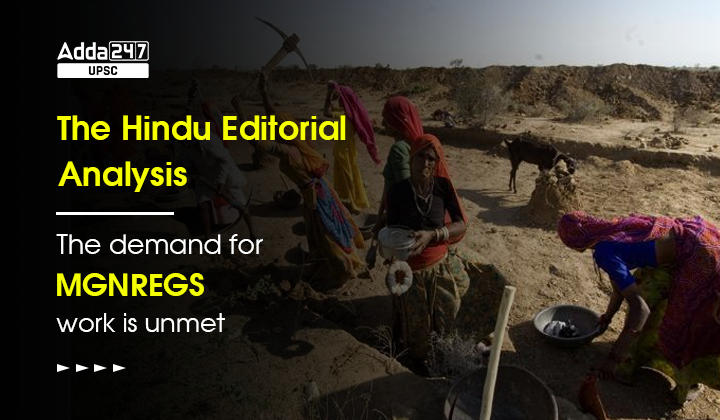Table of Contents
The Hindu Editorial Analysis
The editorial analysis of The Hindu Newspaper Editorial Articles aimed at simplifying various concepts relevant to the UPSC and other State PSC Exams. The Editorial Analysis helps in expanding the knowledge base as well as framing better quality mains answers.
Mahatma Gandhi National Rural Employment Guarantee Scheme (MGNREGA)
Budgetary Allocation for MGNREGA and Associated Issues
The allocation for MGNREGA in the Union Budget 2023-24 is ₹60,000 crore. Budgetary Allocation for MGNREGA is less than 0.2% of the GDP, the lowest ever allocation as a percentage of GDP. World Bank economists had estimated that the allocation should be 1.6% of the GDP.
- Poor Financial Outlay: In the last two years, the new financial year began with more than one-fourth of the allocation as pending wages from previous years.
- Assuming a conservative estimate that the next financial year will begin with pending wages of ₹15,000 crore and accounting for inflation, in real terms, the allocation for MGNREGA will be less than ₹45,000 crore.
- Non-fulfilment of Legal Mandate: A statement by People’s Action for Employment Guarantee and NREGA Sangharsh Morcha has provided an estimate of ₹2.72 lakh crore as the minimum budget required.
- As per this, even ₹1.24 lakh crore can only generate 40 days of work per household per year.
- Increasing Centralization: Aided by a complex technical apparatus, there has been a steady centralisation of the programme architecture even as wages for most States remain lower than minimum agricultural wages.
- Delayed Wage Payments: Wage payment delays continue, and there is evidence that these are caused by inadequate allocations.
- But what has received less attention is the case of unmet demand which is also correlated with inadequate allocations.
- Budget Cuts: Budget cuts have created a vicious cycle of demand suppression, wage payment delays, an overburdened field staff and corruption.
- These further discourage workers from doing MGNREGA work.
MGNAREGA, a Demand-driven Law
MGNREGA is a demand-driven law. Under MGNREGA, Every household must get work within 15 days of demanding work, failing which the workers are legally entitled to an unemployment allowance. But this demand-driven aspect has suffered.
- Getting work and wages is contingent on the household details being entered on the MGNREGA software called the Management Information System (MIS).
- The MIS has been used to subvert the Act in many ways, one of which is work demand suppression.
Issue of Unmet Demand under MGNAREGA
Owing to budgetary constraints, officials usually give fewer days of work to many households or provide many days of work to a few households. Two crore new job cards were issued between 2019-20 and 2022-23 showing the continued demand; yet, the average number of days of employment continues to be around 45 days bearing testimony to demand suppression.
- Unmet demand is defined as the deficit between the work demanded and obtained. Officials don’t even register work demand on the MIS owing to inadequate funds. This can be learned only through surveys.
- Unless details are on the MIS, it is impossible to calculate unmet demand. We present some early estimates of unmet demand from an ongoing study based on MIS data.
- The national MIS reports show the number of households that demanded and got work. The person days of work generated is available nationwide and for each State and panchayat.
- However, the aggregated person days of work demanded at the State and national level is not available as a national MIS report; it is available for each panchayat.
- So, using the national MIS reports we only get an incomplete picture of unmet demand.
- Suppose a household has demanded seven days of work and got three days. Then, as per the national MIS report, since the household demanded and got work, the household-level unmet demand is zero.
- But the person days of unmet demand is four days. There is no national MIS report showing this. To arrive at person days of unmet demand for each State, we have to resort to statistical techniques.
Contradictory Data on Unmet Demand under MGNAREGA
A four State study released in October 2022, conducted by Azim Premji University, NREGA Consortium and CORD, also showed high levels of unmet demand in 2019-20. As per this, 39% of the households did not get a single day of work despite wanting 77 days on average, and those who got at least one day of work wanted 64 days of more work.
- It was found that, to meet the full extent of work demand, the labour Budget should have been three times what was allocated in the surveyed blocks.
- In contrast, the national MIS reports show that the household-level unmet demand for these States was 11%-13% in the last four years.
- The country-wide household unmet demand was in this range too. This means national MIS reports grossly underestimate the unmet demand.
Way Forward
- Ensuring Transparency: For the sake of transparency, the person days of work demanded must be made readily available for each State.
- Addressing the Issue of Centralization and Underfunding: Ground reports suggest that the recent introduction of an app to register workers’ attendance has only increased worker woes.
- This is just the latest in a series of technical fixes when the real problem is underfunding and excessive centralisation.
Parliamentary Panel Report on MGNREGA



 TSPSC Group 1 Question Paper 2024, Downl...
TSPSC Group 1 Question Paper 2024, Downl...
 TSPSC Group 1 Answer key 2024 Out, Downl...
TSPSC Group 1 Answer key 2024 Out, Downl...
 UPSC Prelims 2024 Question Paper, Downlo...
UPSC Prelims 2024 Question Paper, Downlo...
